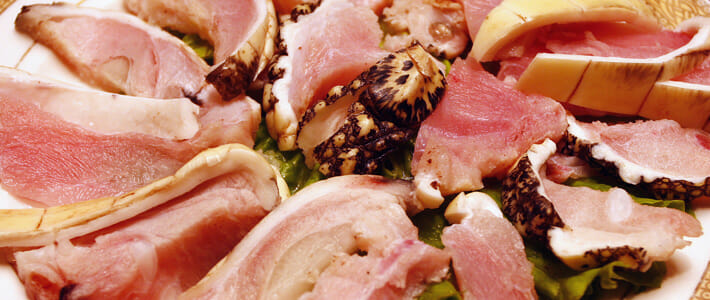Alligator
Alligator Mississippiensis

An alligator is a reptile with large teeth that can grow past 13 ft. long. This ferocious freshwater beast has been around for 66 million years. The highest population can be found in Louisiana, which is where Frugé Seafood gets the majority of their alligator meat that can be shipped right to your door.
The best part of the alligator to eat is the tenderloin, the inner piece of the tail (each tail has two tenderloins), considered to be the “filet mignon” of the gator. The second most desirable part is the white tail meat, and third is the white leg and body meat. The least desirable part of the gator to eat is the red leg meat.
Product pdf for download-
3.5 oz (100g) raw, edible portion
-
Calories 112
-
Calories from Fat 0
-
Total Fat 1.8g/3%
-
Saturated Fat 0g
-
Cholesterol 70.5mg/24%
-
Sodium 0mg/0%
-
Total Carbohydrates 0g/0%
-
Protein 25%.
Texture
Alligator has a tender texture, similar to that of chicken or pork. Just like chicken, it has both white and dark meat. The most sought after meat is the white meat, as it is the most mild and tender.
Quality Control
Alligator meat can be frozen for up to a year if all the fat and tendons are removed.
Preparation
Choice cuts of the alligator are the tail and the jaw, which work best in baked or cutlet recipes as well as in fried foods. If prepared properly (marinated or tenderized), body and leg meat can also be used in special recipes such as burgers, casseroles, ground meat, soups, and stews.
Interesting Fact
Because they are so well cared for, farmed alligators grow twice as fast as their wild counterparts.
Alternatives
Alternatives to alligator are chicken, veal, or pork. Many believe that alligator “tastes like chicken.”
Source
Alternatives to alligator Swamp areas, such as Louisiana and Florida.
Harvest Method
In the wild, alligators are caught by hanging meat on hooks from trees. Farmed alligators can be caught by hand.
Harvest season
Wild harvesting of alligators occurs in September, shortly after the nesting period in July. Harvesting of alligators is controlled through quotas. These quotas are important for keeping the population at a safe level due to alligator’s usefulness in the ecosystem. Farming occurs year-round.
Flavor
Alligator has a mild flavor.
Market Segments
Alligator is appropriate for casual dining, fine dining, hotel, and resort/club segments of the market.